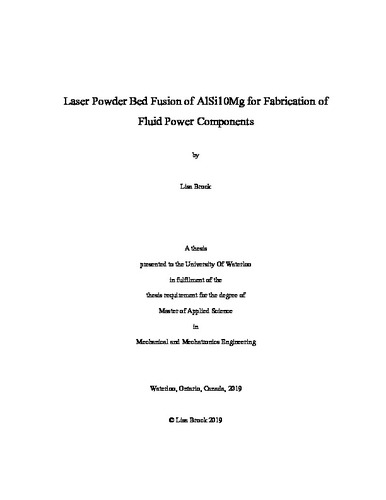| dc.description.abstract | Laser powder bed fusion (LPBF) is an additive manufacturing (AM) process that produces 3D objects in a layer-by-layer fashion by using a laser to selectively melt powdered material. Some of the advantages of LPBF include the potential for more design freedom, reduced waste, and flexible production strategies. It is possible to produce parts with complex geometries that cannot be created through traditional methods without great expense in terms of time, money, and resources. There is no need for expensive tooling, thus enabling fast production of unique designs. To implement LPBF in industry, adopters must develop personalized plans for product qualification, quality assurance, manufacturing, and post-processing requirements. The manufacturing strategy is particularly important, as the machine, material, and process parameters that are used have a large impact on the resulting microstructure and mechanical properties, ultimately controlling the quality of the end-product.
The generation, control, and transmission of fluid power is critical for many engineering applications, such as the automotive transmission pump. Energy losses within the pump reduce the transmission’s ability to convert torque from the engine, so a more efficient, lightweight pump would reduce the fuel consumption of the vehicle. If LPBF is found suitable for the manufacture of aluminum fluid power components, design improvements could be implemented, and custom solutions could be offered to individual customers. This thesis aims to add to the body of knowledge for process development in LPBF of AlSi10Mg in order to improve the resulting part density, surface roughness, and material performance for fluid power applications. The material performance is evaluated through a comparison with an existing product: the cast aluminum pump housing for use in automotive transmissions.
Process parameters were selected for the LPBF of AlSi10Mg on a modulated laser system to minimize porosity and surface roughness, and maximize production efficiency. This was accomplished through the use of initial process mapping, prediction of melt pool dimensions using a thermophysical model, and fine-tune adjustment of parameters. AlSi10Mg powder from two suppliers was characterized for morphology and particle size distribution. The density or solid fraction of manufactured artifacts was evaluated by optical microscopy and x-ray computed tomography (CT), and the surface roughness by laser confocal microscopy. Two process parameter sets were identified for manufacturing fluid power components. A relative density of 99.95% and surface roughness (Sa) of 11.39 μm were achieved.
These process parameters were used to manufacture LPBF artifacts of various geometries for characterization of the relative density, surface roughness, and durability in terms of hardness, wear resistance, and corrosion resistance. The results were compared with benchmark values for a cast aluminum pump housing, which was also characterized for chemical composition and microstructure. The AM artifacts had a lower hardness (54.3 to 69.3 HRB) than the cast pump housing (72.8 to 81.5 HRB). The specific wear rate was determined through the dry sliding wear test, and the AM artifacts (3.92 x10-13 to 6.04 x10-13 m2N-1) had a lower wear resistance than the cast pump housing (2.50 x10-13 to 2.55 x10-13 m2N-1). Cyclic polarization testing revealed that the corrosion resistance and pitting potential were better for the AM artifacts (-0.57 to 0.48 V vs SCE in 0.001M Cl-) than the cast pump housing, which exhibited general corrosion. Linear polarization resistance tests also suggested a better corrosion resistance for the AM artifacts, as the corrosion current density was lower. The surface roughness and durability of three different surface types for the AM artifacts (upskin, sideskin, and polished) and cast pump housing (as-cast, horizontal; as-cast, vertical; and machined) were also compared.
The manufacturability of design features was investigated. Thin walls were printed with thicknesses of 1.0 to 3.0 mm. The wall thickness did not have a significant effect on the part density. Slot artifacts were printed with varying gap widths of 0.5 to 4.5 mm. The interior vertical walls were characterized for surface roughness, which was marginally lower for the smallest and largest gap widths. Straight circular channels were printed with hole diameters of 0.2 to 1.2 mm, and with a height of 10 or 20 mm. Powder was successfully removed from channels with a minimum diameter of 0.5 mm.
Recommendations for future work include performing further in-depth study on the relationship between process parameters and the microstructure of LPBF-processed material in order to better understand and control the resulting mechanical properties. Further development of design constraints, especially those related to non-uniform channels, would also be of use to designers of fluid power components as it would provide more design freedom and ultimately enable innovation. | en |

